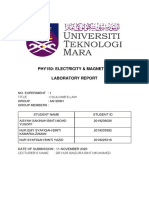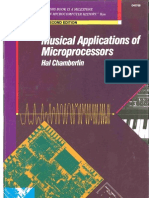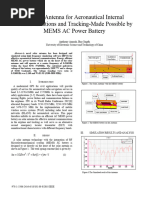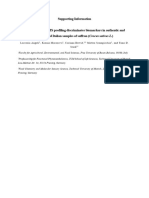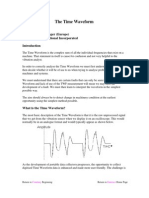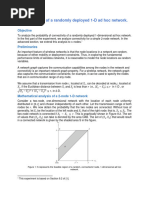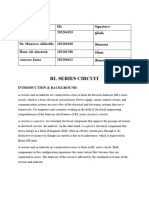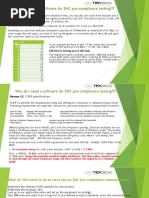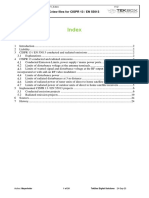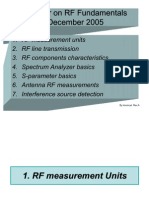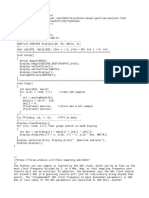AN - RF Current To Electric Field Strength Extrapolation - V1.0
AN - RF Current To Electric Field Strength Extrapolation - V1.0
Uploaded by
Michael MayerhoferCopyright:
Available Formats
AN - RF Current To Electric Field Strength Extrapolation - V1.0
AN - RF Current To Electric Field Strength Extrapolation - V1.0
Uploaded by
Michael MayerhoferOriginal Description:
Original Title
Copyright
Available Formats
Share this document
Did you find this document useful?
Is this content inappropriate?
Copyright:
Available Formats
AN - RF Current To Electric Field Strength Extrapolation - V1.0
AN - RF Current To Electric Field Strength Extrapolation - V1.0
Uploaded by
Michael MayerhoferCopyright:
Available Formats
AN_ RF current to electric field strength extrapolation_V1.0.docx V1.
USING RF CURRENT PROBE MEASUREMENTS
TO EXTRAPOLATE TO RADIATED E-FIELD STRENGTH
1 Introduction
Signal- and power supply cables carrying conducted noise act as antennas and consequently cause
radiated emissions.
Henry Ott and Clayton Paul outlined a method to convert RF current probe measurements into electric field
strength radiated from cables carrying RF currents. It is a derivation/simplification of the full treatment outlined
in “Antenna Theory – Analysis and Design” (C. Balanis).
This application note is based on an excellent article on the website of Andy Eadie from EMC FASTPASS.
The application note explains how this method can be applied, using Tekbox EMCview software. It
automatically creates a graph of radiated emissions, converting a common mode current conducted noise
measurement carried out with a RF current probe and a spectrum analyzer.
Andy Eadie´s article can be found here:
https://emcfastpass.com/current-probe-e-field-emi-testing/
2 A bit of mathematics
“The Formula”
4𝜋 ∙ 10−7 (𝑓 ∙ 𝐼 ∙ 𝐿)𝑠𝑖𝑛𝜃
𝐸=
𝑟
E = electric field strength [V/m]
f = frequency [Hz]
I = CM current [A]
L = cable length [m]
r = measurement distance [m]
Ɵ = π/2
According to Andy Eadie’s article, this formula delivers a very accurate result up until approximately 200
MHz with a 1m cable.
Since we have radiation limits given in dBµV/m and measure RF currents with a spectrum analyzer, we have
to convert the formula into a more practical form.
Substituting field strength and RF current by its logarithmic equivalents:
𝑑𝐵µ𝑉⁄
𝐸 [𝑉⁄𝑚] = 10(𝐸 [ 𝑚]−120)/20
𝐼 [𝐴] = 10(𝐼 [𝑑𝐵µ𝐴]−120)/20
Inserting it into the formula:
𝑑𝐵µ𝑉⁄ 4𝜋 ∙ 10−7 (𝑓 ∙ 𝐿) ∙ 1
10(𝐸 [ 𝑚]−120)/20 = ∙ 10(𝐼 [𝑑𝐵µ𝐴]−120)/20
𝑟
Applying the logarithm to the formula:
𝑑𝐵µ𝑉⁄ 4𝜋 ∙ 10−7 (𝑓 ∙ 𝐿) ∙ 1
log(10(𝐸 [ 𝑚]−120)/20 ) = log ( ) + log(10(𝐼 [𝑑𝐵µ𝐴]−120)/20 )
𝑟
Applying logarithmic rules:
−7
𝑑𝐵µ𝑉⁄ 4𝜋 ∙ 10 (𝑓 ∙ 𝐿)
𝐸[ 𝑚] = 𝐼[𝑑𝐵µ𝐴] + 20 log ( )
𝑟
Substituting I with U being the output voltage of the RF current probe and Z the trans-impedance of the
current probe:
−7
𝑑𝐵µ𝑉⁄ 4𝜋 ∙ 10 (𝑓 ∙ 𝐿)
𝐸[ 𝑚] = 𝑈[𝑑𝐵µ𝑉] − 𝑍[𝑑𝐵Ω] + 20 log ( )
𝑟
Author: Mayerhofer 1 of 5 TekBox Digital Solutions 24-Jun-20
AN_ RF current to electric field strength extrapolation_V1.0.docx V1.0
USING RF CURRENT PROBE MEASUREMENTS
TO EXTRAPOLATE TO RADIATED E-FIELD STRENGTH
3 Using EMCview to measure cable current and display radiated emissions
The formula was converted into a sum of three logarithmic terms, which now can be processed easily by
EMCview:
U [dBµV] is the RF current probe output voltage, measured by the spectrum analyzer
Z [dBΩ] is the trans-impedance versus frequency file of the current probe
4𝜋∙10−7 (𝑓∙𝐿)
20 log ( ) is the “cable current to radiated field strength conversion coefficient”
𝑟
Calculate it for a series of frequency points and the desired values for cable length and measurement distance
using Excel. Next convert it into a cable current to radiated emission conversion file in text format, same as
any other conversion / correction file used for EMCview.
Trans-impedance file and the cable current to radiated emission conversion file can be loaded as either LISN
file, amplitude correction file or cable correction file, since any of those files simply contain coefficients versus
frequency which will be added or subtracted to the measurement values read from the spectrum analyzer.
4 Example
The conversion coefficient shall be calculated for a cable length of 1m and a measurement distance of 3m.
The frequency span shall cover 150 kHz to 200 MHz. The table below shows the results of the Excel
calculation:
Common Mode Conducted Noise Current to Radiated Emissions Conversion
Cable length Measurement Frequency Wavelength/2 Conversion coefficient
[m] distance [m] [MHz] [m] [dB]
1.00 3.00 0.15 999.33 -24.04
0.25 599.60 -19.60
0.50 299.80 -13.58
0.75 199.87 -10.06
1.00 149.90 -7.56
1.50 99.93 -4.04
2.00 74.95 -1.54
2.50 59.96 0.40
3.00 49.97 1.98
4.00 37.48 4.48
5.00 29.98 6.42
7.50 19.99 9.94
10.00 14.99 12.44
12.50 11.99 14.38
15.00 9.99 15.96
17.50 8.57 17.30
20.00 7.50 18.46
30.00 5.00 21.98
40.00 3.75 24.48
50.00 3.00 26.42
75.00 2.00 29.94
100.00 1.50 32.44
125.00 1.20 34.38
150.00 1.00 35.96
175.00 0.86 37.30
200.00 0.75 38.46
The conversion coefficients need to be entered into a conversion file for EMCview. Andy Edie’s article refers
to a paper, which recommends to truncate the conversion factor at the maximum cable length of λ/2 in order
to increase the accuracy of the conversion. Consequently, the conversion value will be truncated at a value of
35.96 dB above 150 MHz when creating the EMCview conversion file.
Author: Mayerhofer 2 of 5 TekBox Digital Solutions 24-Jun-20
AN_ RF current to electric field strength extrapolation_V1.0.docx V1.0
USING RF CURRENT PROBE MEASUREMENTS
TO EXTRAPOLATE TO RADIATED E-FIELD STRENGTH
The conversion factors are now entered into a gain file for EMCview using a plain text editor and saved as
L1m_R3m_current_to_radiated_conversion.amp
Since gain will always be subtracted from the measurement result, the sign of the conversion factor needs to
be reversed in order to be added.
[Application]
Software=TekBox RP-W32-D7
Version=Release
Date=23.06.2020 17:55:55
[General]
Name=L1m_R3m_current_to_radiated_conversion
Freq_Interplot_Mode=log
Level_Interplot_Mode=log
[Data]
Freq1=150000
Lev1=24.04
Freq2=250000
Lev2=19.6
Freq3=500000
Lev3=13.58
Freq4=750000
Lev4=10.06
Freq5=1000000
Lev5=7.56
Freq6=1500000
Lev6=4.04
Freq7=2000000
Lev7=1.54
Freq8=2500000
Lev8=-0.4
Freq9=3000000
Lev9=-1.98
Freq10=4000000
Lev10=-4.48
Freq11=5000000
Lev11=-6.42
Freq12=7500000
Lev12=-9.94
Freq13=10000000
Lev13=-12.44
Freq14=12500000
Lev14=-14.38
Freq15=15000000
Lev15=-15.96
Freq16=17500000
Lev16=-17.3
Freq17=20000000
Lev17=-18.46
Freq18=30000000
Lev18=-21.98
Freq19=40000000
Lev19=-24.48
Freq20=50000000
Lev20=-26.42
Freq21=75000000
Lev21=-29.94
Freq22=100000000
Lev22=-32.44
Freq23=125000000
Lev23=-34.38
Freq24=150000000
Lev24=-35.96
Freq25=175000000
Lev25=-35.96
Freq26=200000000
Lev26=-35.96
Freq27=500000000
Lev27=-35.96
The conversion file is extended to 500 MHz in order to use it for a fast pre-test project for CISPR 32 radiated
noise tests, which makes a fast scan from 10 MHz to 500 MHz using peak detector. Any spurious with high
levels, can then be re-measured using the Quasi Peak detector. The conversion term is linear and in its
logarithmic form also results in a straight line within a logarithmic grid. Consequently it would not be
Author: Mayerhofer 3 of 5 TekBox Digital Solutions 24-Jun-20
AN_ RF current to electric field strength extrapolation_V1.0.docx V1.0
USING RF CURRENT PROBE MEASUREMENTS
TO EXTRAPOLATE TO RADIATED E-FIELD STRENGTH
necessary to involve so many frequency points. In fact, a conversion file with 3 frequency points would be
sufficient, as will be shown below.
The screenshot of EMCview shows the corresponding project, designed to carry out a fast peak scan as
mentioned above.
For an example measurement of the radiated emissions of a Laptop power supply cable, following files were
used and can be downloaded from our website:
EMCview configuration files:
Project file: RN_CISPR32_CLASS_A_3M_conducted to radiated_10M_500M_FAST.prj
Segment file: RN_CISPR32_SEGMENTS_10M_500M_3METER_PEAK_FAST.seg
Limit file: RN_CISPR32_CLASS_A_3METER_QP.lim
Measurement equipment specific files:
TBCP1-500 trans-impedance file: Tekbox_Current_Probe_TBCP1_500.lsc
Coaxial cable loss file: CableSet1.cac
Common mode current to radiated emission conversion file:
1 meter cable length / 3m measuring distance: L1m_R3m_current_to_radiated_conversion.amp
Excel file for the calculation of the conversion coefficients:
CM_current_to_radiated_emission_conversion.xlsx
The screenshot on the following page shows the graphs of the example measurement:
Author: Mayerhofer 4 of 5 TekBox Digital Solutions 24-Jun-20
AN_ RF current to electric field strength extrapolation_V1.0.docx V1.0
USING RF CURRENT PROBE MEASUREMENTS
TO EXTRAPOLATE TO RADIATED E-FIELD STRENGTH
5 History
Version Date Author Changes
V 1.0 23.06.2020 Mayerhofer Creation of the document
Author: Mayerhofer 5 of 5 TekBox Digital Solutions 24-Jun-20
You might also like
- Exp 1 Coulomb's LawDocument9 pagesExp 1 Coulomb's Lawadriana dahlia100% (2)
- ELE302 - PreLab 3Document21 pagesELE302 - PreLab 3hughjass39.99No ratings yet
- GS02-1093 - Introduction To Medical Physics I Basic Interactions Problem Set 3.2b SolutionsDocument6 pagesGS02-1093 - Introduction To Medical Physics I Basic Interactions Problem Set 3.2b SolutionsHanaTrianaNo ratings yet
- Musical Applications of Microprocessors 2ed Chamberlin H 1987Document835 pagesMusical Applications of Microprocessors 2ed Chamberlin H 1987Michael Leydar100% (5)
- ME2142E Feedback and Control Lab - Frequency ResponseDocument9 pagesME2142E Feedback and Control Lab - Frequency ResponseLinShaodun100% (4)
- Nee2102 Experiment Report 5Document13 pagesNee2102 Experiment Report 5Lynndon VillamorNo ratings yet
- EMCview - Files - CISPR 11 - EN 55011 - V1 - 3Document25 pagesEMCview - Files - CISPR 11 - EN 55011 - V1 - 3Michael MayerhoferNo ratings yet
- AN - Pre - Compliance - Radiated - Noise - Measurements - V1 - 0Document7 pagesAN - Pre - Compliance - Radiated - Noise - Measurements - V1 - 0Michael MayerhoferNo ratings yet
- Experiment No. 2 Spectral Analysis of Signal HarmonicsDocument13 pagesExperiment No. 2 Spectral Analysis of Signal HarmonicsJoyce MalabananNo ratings yet
- Exp 13Document5 pagesExp 13neha yarrapothuNo ratings yet
- Figure1: Cricuit DiagramDocument3 pagesFigure1: Cricuit Diagramtajul tonoyNo ratings yet
- International Islamic University, Islamabad: Antennas and Wave Propagation LabDocument6 pagesInternational Islamic University, Islamabad: Antennas and Wave Propagation LabTayyaba MunawarNo ratings yet
- Qatar University Core Curriculum Requirement: Instructor: Mrs. Huda Al Yafei Spring 2021 - L04Document7 pagesQatar University Core Curriculum Requirement: Instructor: Mrs. Huda Al Yafei Spring 2021 - L04yousefNo ratings yet
- Tabla de Impedancia Cables Media TensionDocument7 pagesTabla de Impedancia Cables Media Tensionvcontrerasj72No ratings yet
- Optics ExampleDocument13 pagesOptics Exampledlapsn86No ratings yet
- Research On Signal of Field Monitor of 7220A Localizer Beacon Subsystem of ILSDocument14 pagesResearch On Signal of Field Monitor of 7220A Localizer Beacon Subsystem of ILSĐào Nguyên TuếNo ratings yet
- 08563520Document3 pages08563520sivasugan28No ratings yet
- Qbase Isolation DesignDocument27 pagesQbase Isolation Designprraaddeej chatelNo ratings yet
- Control Systems Laboratory: Hamza OSAMA &haider Jamal&salah MahdiDocument27 pagesControl Systems Laboratory: Hamza OSAMA &haider Jamal&salah MahdiAhmed Mohammed khalfNo ratings yet
- Biot Savarts LawDocument13 pagesBiot Savarts Lawubaidnazir45198No ratings yet
- P. Strock: F o Ucault Calculations For 5 ZonesDocument4 pagesP. Strock: F o Ucault Calculations For 5 ZonesdanyNo ratings yet
- Lab 2 Ee 463Document12 pagesLab 2 Ee 463Aashutosh PratapNo ratings yet
- Lab Report 3 - Edm Calibration: AbstractDocument2 pagesLab Report 3 - Edm Calibration: AbstractAman JainNo ratings yet
- ECNG 2001 Communication Systems I (Semester II 2015/2016) Final (60%)Document7 pagesECNG 2001 Communication Systems I (Semester II 2015/2016) Final (60%)JellyJelloNo ratings yet
- Lab Reports PCTDocument34 pagesLab Reports PCTaamir.faiazNo ratings yet
- Wind Turbine Pitch Adjustment Scheme Design ExerciseDocument21 pagesWind Turbine Pitch Adjustment Scheme Design ExerciseMark RocheNo ratings yet
- 518kHz Navtex ReceptionDocument18 pages518kHz Navtex ReceptionJose Antonio López FernándezNo ratings yet
- ACS Food Sci. Technol. (2024) 4 (11) p1783 1794-SDocument18 pagesACS Food Sci. Technol. (2024) 4 (11) p1783 1794-Sr13641028No ratings yet
- Lab Report 1 Traffic NoiseDocument13 pagesLab Report 1 Traffic Noisehanna humairaNo ratings yet
- Report 3 Rot2 Farid MammadovDocument12 pagesReport 3 Rot2 Farid Mammadovfaridcappuccino1501No ratings yet
- Physics F3 PP3 MSDocument4 pagesPhysics F3 PP3 MSbettabuu1No ratings yet
- B3Document12 pagesB3EMMANUEL BOADINo ratings yet
- Helical Antenna Testing v2Document9 pagesHelical Antenna Testing v2Arsalan JawedNo ratings yet
- VibrationTime WaveformDocument12 pagesVibrationTime Waveformramtce100% (1)
- Chapter 9Document15 pagesChapter 9Fanny Sylvia C.No ratings yet
- ACT2.MGSC AhorroEne-2009040Document14 pagesACT2.MGSC AhorroEne-2009040miguelgsc04No ratings yet
- Report MSC1Document9 pagesReport MSC1Afwan AriffinNo ratings yet
- Connectivity of 1D Ad Hoc Networks - v13.3Document14 pagesConnectivity of 1D Ad Hoc Networks - v13.3kanagaraj2331993No ratings yet
- 6th Sem ExlDocument22 pages6th Sem Exlrakesh kumarNo ratings yet
- Nozzle Reaction ForceDocument17 pagesNozzle Reaction ForceRIPUDAMAN SINGHNo ratings yet
- International Islamic University, Islamabad: Antennas and Wave Propagation LabDocument5 pagesInternational Islamic University, Islamabad: Antennas and Wave Propagation LabTayyaba MunawarNo ratings yet
- Analysis of The System (Kelompok 2)Document8 pagesAnalysis of The System (Kelompok 2)dwi safitriNo ratings yet
- Intrumentation Lab#5Document7 pagesIntrumentation Lab#5Ahsan IjazNo ratings yet
- Celec Exp#5Document4 pagesCelec Exp#5Felix2ZNo ratings yet
- Blackbody Radiation SpectrumDocument3 pagesBlackbody Radiation SpectrumernaNo ratings yet
- Form 3: Physics Paper 3 Marking SchemsDocument4 pagesForm 3: Physics Paper 3 Marking SchemsBenjamin mwanikiNo ratings yet
- Lab 2Document3 pagesLab 2huzaifa zainNo ratings yet
- Exp04Document4 pagesExp04asifasmat14No ratings yet
- Class 12TH Practical ReadingsDocument14 pagesClass 12TH Practical ReadingsLakshya AgrawalNo ratings yet
- RL Series Circuit - Math Project 2Document10 pagesRL Series Circuit - Math Project 2sllhahadlNo ratings yet
- Ee303 Lab8Document7 pagesEe303 Lab8Tariq AlharbiNo ratings yet
- Lab 9Document5 pagesLab 9charmidenNo ratings yet
- The Lost Art of Nomography Ron DoerflerDocument38 pagesThe Lost Art of Nomography Ron DoerflerRaymond Carlson100% (1)
- Implementation of 1-D Contourlet Transform in Matlab: PresentationDocument14 pagesImplementation of 1-D Contourlet Transform in Matlab: PresentationJai SidharthNo ratings yet
- Wind SolnsDocument6 pagesWind SolnsJosef PlenoNo ratings yet
- Data Hasil Mohamad FadliDocument7 pagesData Hasil Mohamad FadliMuhammad IkramullahNo ratings yet
- Comparison of WiFi Amplifiers As Output Power Amplifier For QO-100 Transmit Converter - RA3APW Personal WebsiteDocument15 pagesComparison of WiFi Amplifiers As Output Power Amplifier For QO-100 Transmit Converter - RA3APW Personal WebsiteVictor P (YO4TNV)No ratings yet
- MM Bakhmeteff Paolo RamosDocument21 pagesMM Bakhmeteff Paolo RamosPaolo RamChNo ratings yet
- Project Management and Economics: Project Base Learning AssignmentDocument11 pagesProject Management and Economics: Project Base Learning AssignmentUsmanNo ratings yet
- Tugasan/Assignment 5 (20 Markah/marks) : Serial NoDocument4 pagesTugasan/Assignment 5 (20 Markah/marks) : Serial NoNurul FadzillahNo ratings yet
- Lab 4Document6 pagesLab 4Sadav ImtiazNo ratings yet
- Cable Sched & Complete VD For 4.0%Document69 pagesCable Sched & Complete VD For 4.0%Nidez GbayarongNo ratings yet
- Application of Spread SheetDocument11 pagesApplication of Spread SheetTrushti SanghviNo ratings yet
- TBAS3 - N - Attenuator - Set - 10W - 3 GHZ - V1.0 - 20231102Document3 pagesTBAS3 - N - Attenuator - Set - 10W - 3 GHZ - V1.0 - 20231102Michael MayerhoferNo ratings yet
- AN Conducted Noise Measurement - Tekbox LISN TBLC08 - EMCviewDocument9 pagesAN Conducted Noise Measurement - Tekbox LISN TBLC08 - EMCviewMichael MayerhoferNo ratings yet
- TBAS4 - N - Attenuator - Set - 2W - 6 GHZ - V1.0 - 20231102Document3 pagesTBAS4 - N - Attenuator - Set - 2W - 6 GHZ - V1.0 - 20231102Michael MayerhoferNo ratings yet
- TBL05100 - 1 - LISN Manual - V1 - 0 - 20230607Document11 pagesTBL05100 - 1 - LISN Manual - V1 - 0 - 20230607Michael MayerhoferNo ratings yet
- TBTWR 1.2NM N 20mm - 19mmDocument1 pageTBTWR 1.2NM N 20mm - 19mmMichael MayerhoferNo ratings yet
- TBL5016 - 3 - Manual - V1.4 - 20221129Document20 pagesTBL5016 - 3 - Manual - V1.4 - 20221129Michael MayerhoferNo ratings yet
- Tekbox EMIview Quick Start Guide V1.0Document4 pagesTekbox EMIview Quick Start Guide V1.0Michael MayerhoferNo ratings yet
- FAQ - EMCview V1 - 8Document33 pagesFAQ - EMCview V1 - 8Michael MayerhoferNo ratings yet
- Why Do I Need A Software For EMC Measurements V1 - 0Document3 pagesWhy Do I Need A Software For EMC Measurements V1 - 0Michael MayerhoferNo ratings yet
- TBCCP1 - 400K600 ManualDocument7 pagesTBCCP1 - 400K600 ManualMichael MayerhoferNo ratings yet
- Tbcg1: Radiating Comb GeneratorDocument17 pagesTbcg1: Radiating Comb GeneratorMichael MayerhoferNo ratings yet
- Index: Emcview Files For Cispr 22 / en 55022Document14 pagesIndex: Emcview Files For Cispr 22 / en 55022Michael MayerhoferNo ratings yet
- Tekbox EMCview Manual V2 - 1Document29 pagesTekbox EMCview Manual V2 - 1Michael MayerhoferNo ratings yet
- Comb Generator / Frequency Multiplier: Tbcg2Document6 pagesComb Generator / Frequency Multiplier: Tbcg2Michael MayerhoferNo ratings yet
- FAQ - EMCview V1 - 7Document27 pagesFAQ - EMCview V1 - 7Michael MayerhoferNo ratings yet
- An Conducted Noise Measurement - Tekbox LISN TBOH01 and EMCview - V1 - 1Document26 pagesAn Conducted Noise Measurement - Tekbox LISN TBOH01 and EMCview - V1 - 1Michael MayerhoferNo ratings yet
- Index: Emcview Files For Cispr 15 / en 55015Document8 pagesIndex: Emcview Files For Cispr 15 / en 55015Michael MayerhoferNo ratings yet
- 5Μh Lisn Manual: © 2017 Tekbox Digital SolutionsDocument13 pages5Μh Lisn Manual: © 2017 Tekbox Digital SolutionsMichael MayerhoferNo ratings yet
- EMCview - Files - CISPR 14 - EN 55014 - V1 - 1Document18 pagesEMCview - Files - CISPR 14 - EN 55014 - V1 - 1Michael MayerhoferNo ratings yet
- TBSB Shielded Bags 20190417Document14 pagesTBSB Shielded Bags 20190417Michael MayerhoferNo ratings yet
- EMCview - Files - CISPR 13 - EN 55013 - V1 - 2Document24 pagesEMCview - Files - CISPR 13 - EN 55013 - V1 - 2Michael MayerhoferNo ratings yet
- TBST Tents 20190523Document8 pagesTBST Tents 20190523Michael MayerhoferNo ratings yet
- Pre Compliance Conducted Emission Measurements V1 - 1Document22 pagesPre Compliance Conducted Emission Measurements V1 - 1Michael MayerhoferNo ratings yet
- EMC Pre Compliance TestingDocument12 pagesEMC Pre Compliance TestingMichael MayerhoferNo ratings yet
- Which Standard Has To Be Applied For My ProductDocument22 pagesWhich Standard Has To Be Applied For My ProductMichael MayerhoferNo ratings yet
- A770 A790 Ce Emi ReportDocument56 pagesA770 A790 Ce Emi ReportthanatitosNo ratings yet
- Keysight N9020A User ManualDocument3,307 pagesKeysight N9020A User Manualjacobcurtis24No ratings yet
- Hyperspectral GuideDocument17 pagesHyperspectral GuidesooommmNo ratings yet
- E1065-99 Evaluating Characteristics of Ultrasonic Search UnitsDocument21 pagesE1065-99 Evaluating Characteristics of Ultrasonic Search UnitsEnrique AntonioNo ratings yet
- Field Test 7 Index: March 2, 2016 IDocument4 pagesField Test 7 Index: March 2, 2016 IbokibokyNo ratings yet
- Electronic Measurements and Instrumentation QBDocument9 pagesElectronic Measurements and Instrumentation QBSridhar Koneru VenkkatNo ratings yet
- Institute of Aeronautical Engineering (Autonomous) : Electronics and Communication EngineeringDocument37 pagesInstitute of Aeronautical Engineering (Autonomous) : Electronics and Communication EngineeringMano HarNo ratings yet
- Devices Using Ultra-Wideband (UWB) Technology: RSS-220 Issue 1 March 2009Document19 pagesDevices Using Ultra-Wideband (UWB) Technology: RSS-220 Issue 1 March 2009AyubUnvedNo ratings yet
- Conducted Emission Study in Space Vector Modulated Voltage Source InverterDocument10 pagesConducted Emission Study in Space Vector Modulated Voltage Source InverterInternational Journal of Power Electronics and Drive SystemsNo ratings yet
- 5f501dd4a3ccb3aa080ff412 - Deviser DS2831 - User Guide - v181214 - CompressedDocument189 pages5f501dd4a3ccb3aa080ff412 - Deviser DS2831 - User Guide - v181214 - Compressedjean claude lionel ng'anyogoNo ratings yet
- Wireless World 1990 01 PDFDocument92 pagesWireless World 1990 01 PDFMilton Nast100% (1)
- Matlab Tutorial For DSPDocument876 pagesMatlab Tutorial For DSPilgimdemirel100% (3)
- Agilent Digital Modulation LabDocument8 pagesAgilent Digital Modulation LabEndah FitrianiNo ratings yet
- Entry Level RF Engineer Resume SampleDocument5 pagesEntry Level RF Engineer Resume Sampleafllmmkse100% (1)
- RF BasicsDocument51 pagesRF BasicsIrshad HaqNo ratings yet
- AMTA2006 Bonefacic Bartolic J - TomekDocument7 pagesAMTA2006 Bonefacic Bartolic J - Tomekhajbaba0098No ratings yet
- Arduino Spectum AnalyzerDocument4 pagesArduino Spectum Analyzernguyen van ANNo ratings yet
- Design and Analysis of RF Microwave Systems For CommunicationsDocument6 pagesDesign and Analysis of RF Microwave Systems For Communicationsbavar88No ratings yet
- Caddo Spectrum Analyzer 80058005TGDocument27 pagesCaddo Spectrum Analyzer 80058005TGilesh22No ratings yet
- 2018 Tek ProductCatalogQ1Document139 pages2018 Tek ProductCatalogQ1Apollos_80No ratings yet
- Brochure2010 en LDocument70 pagesBrochure2010 en Lbharat_22nandula100% (1)
- Ubiquity airOS User Guide PDFDocument67 pagesUbiquity airOS User Guide PDFEdea SyllisyaNo ratings yet
- Interference Identification MitigationDocument30 pagesInterference Identification Mitigationflatelecom938No ratings yet
- ANRITSU S331B Datasheet PDFDocument13 pagesANRITSU S331B Datasheet PDFParco Camasca VidalNo ratings yet
- Datasheet SRM3006 EN PDFDocument20 pagesDatasheet SRM3006 EN PDFMark LionNo ratings yet
- IStroboSoft Inapp ContentDocument11 pagesIStroboSoft Inapp Content15101980No ratings yet
- Cisco CleanAir: Spectrum Analyzers Are Not All Created EqualDocument37 pagesCisco CleanAir: Spectrum Analyzers Are Not All Created EqualCisco Wireless100% (1)
- Performance Investigation of Visible Light Communication System Using Optisystem Simulation ToolDocument8 pagesPerformance Investigation of Visible Light Communication System Using Optisystem Simulation ToolLuisNo ratings yet
